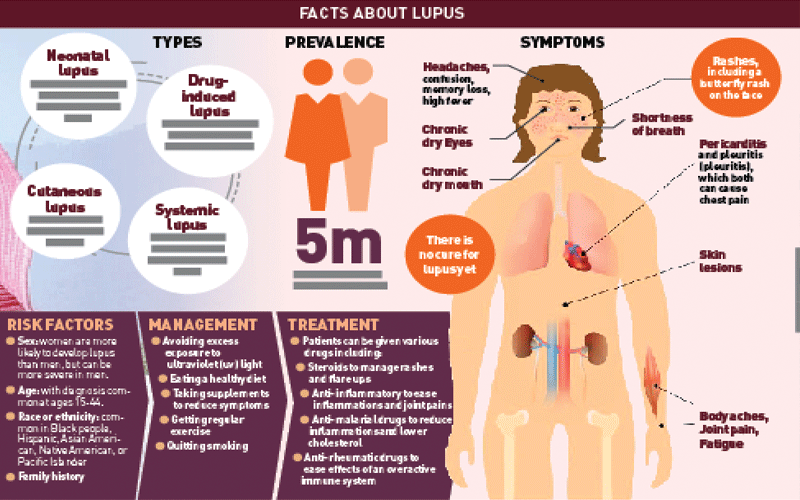My body was set to destroy itself with this disease
By ann nyathira, June 29, 2020After years of hospital visits for various ailments, Winnie Opondo had had enough of it until she was diagnosed with lupus.
“Before the diagnosis, I used to have pain on my feet and fingers that would often turn cold or numb.
The doctors would put me on antibiotics which helped for several weeks, but the pain and numbness would always resurface,” starts Winnie Opondo.
She was used to being in and out of hospital, and during this period she was treated for pneumonia, hyperacidity, nerve problems, and sepsis.
Every time she thought she was cured, some other ailment always unceremoniously showed up.
During her pregnancy, her condition became worse and walking became a difficult task.
“When I gave birth I was in so much pain, I did not have the strength to hold my own child.
You can imagine the kind of trauma I was going through as a mother: not being able to hold my child hurt me a lot.
There were days I would wake up and I could not even wash my face because my fingers were swollen and the pain was unbearable. There were days I would crawl because of the pain,” she says.
Tricky disease
One day she woke up and one half of her body top to bottom was in an insufferable pain she thought her head would fall off.
“It was as if there was a pain workshop going on in my body. I had excruciating abdominal and joint pains that made me crawl.

I went to Aga Khan University Hospital, and the doctor thought it was arthritis, so again I was put on antibiotics.
I went to see a rheumatologist the samples were sent to South Africa and the results came back positive,” she says.
In 2018, Winnie was diagnosed with Lupus (systemic lupus erythematosus): a chronic autoimmune disease that can cause damage, including pain and inflammation in many parts of the body, including the joints, skin, kidneys, heart, lungs, blood vessels, nervous system, and brain.
For years, she battled an illness she could not put a name to. It was always one illness after another, and the physical and the mental implication of the condition massively affected her.
“Because lupus is not only tricky to diagnose, but also tricky to understand, I had a hard time understanding why my own body was set out to destroy itself. This just did not sit well with me.
The doctors giving a name to the condition did not make things easy for me initially. Here you have this revelation that you have a fatal chronic illness; that it does not have a cure really hit me hard.
I grieved for my good health. People have little understanding about my condition and this makes it even worse,” says Winnie.
Life is unpredictable for Winnie and many others with this condition. One minute you are fine, and the next you cannot even hold a toothbrush or a pen.
This has really made it challenging for her to work, but she says it is something she has learned to deal with even when the symptoms flare-up.
“Sometimes you can be in so much pain, but you cannot tell not even your family members or colleagues because they will think you are pretending, especially at work.
Another thing you cannot miss work that often because you do not want to underperform,” she says.
Winnie says when you have a condition such as lupus, it is best to follow your treatment plan and take good care of yourself. One of the trickiest things, she says, is learning how to keep up with an unpredictable disease.
“I have had to develop the ability to determine when I am too tired or run down so that I can rest before I send myself into a lupus flare-up.
Also, I have to stay away from the sun and keep my stress level low because it can send me into a flare-up too,” she says.
Dr Fred Otieno, a rheumatologist, says lupus is a chronic autoimmune disease that occurs when the body’s immune system attacks its own healthy organs and tissues— and it can often take years to diagnose.
He adds that lupus can also sometimes be mistaken for other illnesses. Why? The symptoms are often non-specific and vary widely.
They include fatigue, joint pain, swelling, fever, and rashes, especially what is called a “butterfly rash,” which stretches across both cheeks and looks like a sunburn.
“Lupus can present itself as anything: it can be a skin rash, ulcers in the mouth, loss of hair, joint pains, internal organs involvement, nerve system involvement, and kidney failure.
Because of its nature, someone can be treated for stroke or arthritis yet they have lupus,” he explains.
Minimal data
But what are some of the factors that predispose an individual to Lupus?
“Lupus is said to be genetic, but it is not clear how these genes can be predisposed to lupus. It is hormonal and that is why the condition affects more women compared to men.
Although Lupus is a lifelong disease that can affect many parts of your life, when patients are diagnosed early, it can be treated and they can understand how to take steps to control symptoms, prevent lupus flare-ups and cope with the challenges of disease,” he adds.
Dr Otieno notes the importance of raising awareness about this subtle, but deadly and financially draining health condition.
According to him, people with lupus do not have an insurance cover since most companies never consider lupus a serious ailment.
He advises the best way to keep lupus at bay is by following the treatment plan and taking care of yourself.
“Dealing with a chronic disease like lupus can be challenging. Learning how to tell when the flare is coming is crucial, reducing stress by setting realistic goals for yourself and limit the time you spend in the sun and in fluorescent and halogen light will help a great deal in controlling the condition,” he explains.
Dr Otieno notes there is minimal data on lupus in the country, but says the numbers could be high because of its complex nature that makes it cumbersome to understand and diagnose.
